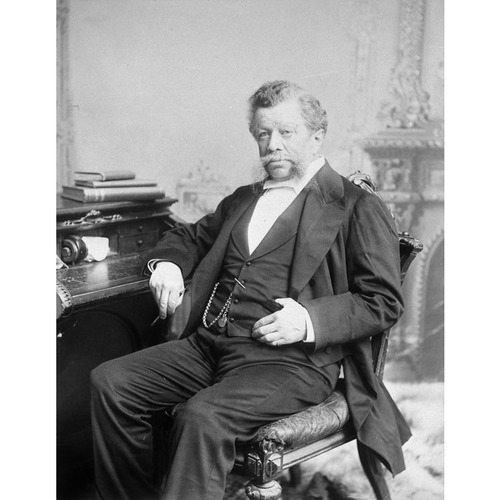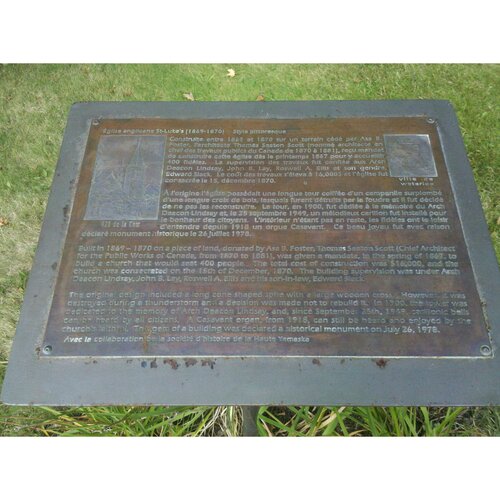SCOTT, THOMAS SEATON, architect and office holder; b. 16 Aug. 1826 in Birkenhead, England; m. 28 April 1859 Mary Mackenzie in Montreal, and they had three sons and a daughter; d. 15 or 16 June 1895 in his Ottawa home.
Thomas Seaton Scott apprenticed to a qualified architect-engineer, apparently his elder brother Walter. From January to August of 1850 he toured the Continent to see and to draw the great works of earlier periods. Late in 1855 or early in 1856 Scott emigrated to the Canadas, according to family tradition in the flood of mechanics and professionals hired to work on the construction of the Victoria Bridge in Montreal [see James Hodges*]. He left three sketches of the bridge but no record has yet been found to define his precise role in its design or building. His marriage to the daughter of William S. Mackenzie, the Grand Trunk Railway’s locomotive manager, may have been helpful in securing contracts from the company. During his lifetime Scott designed a number of important works for the railway, ranging from its largest stations, at Toronto (opened in 1873) and Montreal (opened in 1889), to a group of much smaller facilities along the line from Quebec to Trois-Pistoles. He also laid out Grand Trunk property at Pointe Saint-Charles for residential purposes.
Scott’s railway and family connections, coupled with a modest skill in design, led to a number of other local commissions. His largest (and most problematic) undertaking was the completion of Christ Church Cathedral in Montreal on the death of its original architect, Frank Wills*. Hired in 1857 on the explicit understanding that he was not to modify Wills’s plans, Scott later was to be sued along with the contractors for the inadequacy of the foundations which Wills had prescribed. Himself a Presbyterian, Scott designed a number of churches, all of which are currently extant, for Anglican congregations at Prescott (1858), Ottawa (1868–69), Waterloo, Que. (1871), Cornwall (1868–9), and Murray Bay (Pointe-au-Pic), Que. He is credited with the design of several houses for members of the bourgeoisie in Montreal, and one residence in Maitland, Ont.
By 1871 Scott seems to have been a moderately successful architect in private practice. Corporate and family connections had ensured a steady income but it was an unspectacular career, unusual only in that his commissions ranged across the Canadas at a time when architects generally restricted their work to the city of their practice. His identified buildings suggest a skill in, and feel for, the spirit and details of the waning Gothic Revival style but a definite heavy-handedness in more modern approaches to design, such as the Italianate and the Second Empire. In 1871 Scott’s career took a dramatic turn when he was appointed, on 24 May, the architect to the dominion Department of Public Works, a client for whom he had hitherto performed no work whatsoever. On 17 Feb. 1872 he was promoted to the post of chief architect to the department, the first person to hold this title.
Scott’s appointment, his family claimed later, was due to the influence of Sir George-Étienne Cartier*, the long-time chief counsel for the Grand Trunk. Certainly neither professional standing nor any other known connection explains it. Starting as Public Works’ sole architectural employee, Scott created and then slowly built the chief architect’s branch into the largest building design firm in the country. For the preparation of plans and elevations for new structures, the federal government initially hired architects in private practice on a job-by-job basis; in the fiscal year 1870–71 the three new buildings constructed by the department followed plans prepared by private architects. Gradually Scott was empowered to hire staff and prepare designs in-house, until by the fiscal year 1880–81, 35 major buildings were planned or under way, only two of which (post offices at Belleville and St Catharines, Ont.) were built to plans by outsiders. Departmental reports and surviving correspondence indicate that Scott was neither an active practising architect nor a major influence in setting federal design policy. Rather, he served primarily as an administrator; his most important contribution to the department was in his hiring and moulding a design staff of acknowledged professional skills, the establishment of procedures for the handling of outside contracts and for internal management, and the gradual building up of what seems to have been the largest concentration of architectural expertise in the country. As an architect, he was apparently directly involved in only one project. The extension of the West Block of the parliamentary complex in Ottawa, begun in 1875, is the sole structure that is clearly Scott’s own work. In addition, he himself revised the plans of the New York landscape architect Calvert Vaux for the grounds of Parliament Hill.
Scott’s influence on federal building policies was equally slight. Shortly before he arrived in Ottawa, the government appears to have adopted a somewhat stripped and simplified handling of the Second Empire style as a consistent architectural approach that would provide a unified image for federal buildings across the new country. Scott’s pre–1871 work in this mode revealed no special affinity for, or adeptness in, the style, and federal structures designed by his staff show distinction neither in the quality of artistic execution nor in the decoration or arrangement of interior spaces. Only in the use of iron as a support system – surely a result of his railway experience – was the department part of the advance within the architectural profession. Under Scott’s respected successor, Thomas Fuller, the department became markedly more skilled in producing high-quality exterior designs, though in structural matters, such as the use of cast iron, it became rather more conservative.
Scott resigned because of ill health on 7 Sept. 1881 but a series of administrative manœuvres resulted in his receiving early retirement on 4 November and a superannuation award of $660 per annum. After his retirement, he lived quietly and in near obscurity in Ottawa until his death from heart disease in 1895. He left a small estate consisting of a house (presumably of his own design, and now a small hotel), his personal effects, and cash in the amount of $2,800. Scott had been one of five Canadian architects appointed a charter member of the Royal Canadian Academy of Arts on its founding in 1880 [see Lucius Richard O’Brien], donating as his diploma piece his drawing of Union Station, Toronto. He replaced it a year later with three drawings of his West Block extension. He contributed four sketches to the 1882 show and served without distinction on the council from 1880 to 1891 and again from 1893 until his death.
Thomas Seaton Scott was a moderately skilled member of the Montreal architectural and engineering community in the 1850s and 1860s, a time when the city boasted several designers of superior attainments. His appointment to the Department of Public Works illustrates the pervasive influence of railways in federal politics and administration in the immediate post-confederation period, the triumph of connections and a modest administrative capacity over recognized professional ability. In his post, and in private commissions both before and after his appointment, Scott showed no particular grasp of new architectural currents. Indeed, his last known work, Bonaventure Station, was notable for its old-fashioned appearance. His major achievement was the formation and early development of the chief architect’s branch in the Department of Public Works but his accomplishments there, largely bureaucratic, were clearly overshadowed by the design and administrative record of his successor.
[The slight uncertainty concerning the exact date of Scott’s death is a result of discrepancies in the primary sources. His death date is given as 15 June 1895 in the burial reg. of the Mount Royal Cemetery Company (Outremont, Que.) and in the burial register of St Andrew’s Presbyterian Church (Montreal), cited below. The application for probate of his will (AO, RG 22, ser.354, no.2672), however, records his death date as “on or about 15 June 1895,” and it appears as the 16th of June on the tombstone of T. S. and Mary Scott in Mount Royal Cemetery (plot C-547).
A comprehensive list of public buildings erected during Scott’s tenure as chief architect appears in Can., Dept. of Public Works, General report of the minister of public works for 1867 to 1882 (Ottawa, 1884), app. 1. d.j.]
ANQ-M, CE1-125, mars 1865; Division cartographique, P1000/50-598. Church of St Andrew and St Paul (Presbyterian) (Montreal), St Andrew’s, reg. of baptisms, marriages, and burials, 1859: f.30; 1860–61: f.26; 1862–63: f.33; 1892–1909: f.70. Grenville County Hist. Museum (Prescott, Ont.), Report of the building committee of St John’s Church, Prescott, 6 March 1860 [Reference courtesy of Stephen A. Otto. Toronto. d.j.]. NA, RG 2, 4, vol.3, no.1021; vo1.4, no. 131; vol.13, nos. 1273, 1446, 1463; RG 55, A4, 424, no.2816; Cartographic and Architectural Arch. Division, RG 11M, Acc. 83403/55. St Andrew’s Presbyterian Church (Ottawa), Reg. of baptisms, 1872 (mfm. at AO). Can., Dept. of Public Works, Report of the minister (Ottawa), 1871: 47–51; 1876, app. 17: 4; 1881: xiv–xxi. Canadian Architect and Builder (Toronto), 2 (1889): 9. Canadian Illustrated News (Montreal), 17 July 1871, 11 Dec. 1875, 18 May 1878. Gazette (Montreal), 18 June 1895. La Minerve, 3 août 1858. Ottawa Citizen, 17 June 1895. Times (Ottawa), 11 May 1868. Ottawa directory, 1869–70: 97–98. Royal Canadian Academy of Arts; exhibitions and members, 1880–1979, comp. E. de R. McMann (Toronto, 1981). Wallace, Macmillan dict. F. D. Adams, A history of Christ Church Cathedral, Montreal (Montreal, 1941), 75–85 [Scott’s name is mistranscribed as Thomas S. Salt]. Margaret Archibald, By federal design: the chief architect’s branch of the Department of Public Works, 1881–1914 (Ottawa, 1983). Philippe Dubé et Jacques Blouin, Deux cents ans de villégiature dans Charlevoix: l’histoire du pays visité (Québec, 1986), 119. H. E. MacDermot, Christ Church Cathedral; a century in retrospect ([Montreal, 1959]; repr. 1978). N. McF. MacTavish, The fine arts in Canada (Toronto, 1925; repr. [with intro. by Robert McMichael], 1973) [The entry for Scott contains numerous inaccuracies. d.j.]. D. [R.] Owram, Building for Canadians: a history of the Department of Public Works, 1840–1960 ([Ottawa], 1979). C. [A.] Thomas, “Architectural image for the dominion: Scott, Fuller and the Stratford Post Office,” Journal of Canadian Art Hist. (Montreal), 3 (1976), no.1–2: 83–94. Janet Wright, “Thomas Seaton Scott: the architect versus the administrator,” Journal of Canadian Art Hist., 6 (1982), no.2: 202–18.
Cite This Article
Dana Johnson, “SCOTT, THOMAS SEATON,” in Dictionary of Canadian Biography, vol. 12, University of Toronto/Université Laval, 2003–, accessed December 17, 2025, https://www.biographi.ca/en/bio/scott_thomas_seaton_12E.html.
The citation above shows the format for footnotes and endnotes according to the Chicago manual of style (16th edition). Information to be used in other citation formats:
| Permalink: | https://www.biographi.ca/en/bio/scott_thomas_seaton_12E.html |
| Author of Article: | Dana Johnson |
| Title of Article: | SCOTT, THOMAS SEATON |
| Publication Name: | Dictionary of Canadian Biography, vol. 12 |
| Publisher: | University of Toronto/Université Laval |
| Year of publication: | 1990 |
| Year of revision: | 1990 |
| Access Date: | December 17, 2025 |






